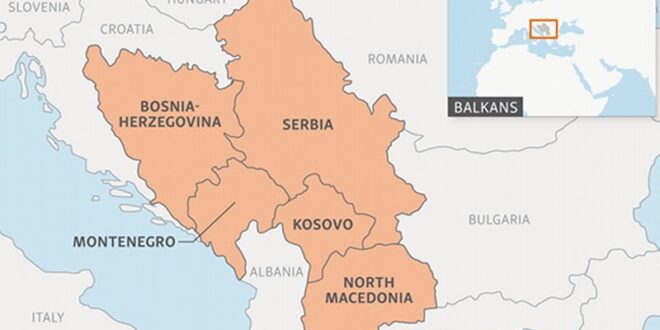The Western Balkans is transforming into one of the primary fronts of confrontation between global powers, where Russia’s and Serbia’s hybrid strategies directly challenge the stability and sovereignty of countries in the region. This paper examines the complex dimensions of this hybrid warfare, focusing on recent attacks in Banjska and Zvecan, which signify a deliberate escalation aimed at destabilizing Kosovo. Through the use of demographic manipulations, sabotage of critical infrastructure, and the provocation of ethnic tensions, Russia and Serbia are leveraging the Balkans as a battleground to advance their strategic projects, such as “Srpski Svet” and “Ruski Mir”.
By comparing this approach to cases in Georgia and Ukraine, this essay highlights the use of hybrid tools, from propagandistic narratives to direct interventions, as a model for undermining democratic structures and increasing influence in the region.
Lessons from Georgia and Ukraine: parallels to hybrid strategies in the Balkans
Hybrid warfare is no longer in terms of “threat” but in real and tangible terms. A comparative example from the Western Balkans is Russia’s hybrid warfare in Georgia and Ukraine, two cases where hybrid tactics have led to severe destabilization and territorial intrusions. In Georgia, hybrid interventions began with support for separatists in South Ossetia and Abkhazia, escalating into the 2008 conflict. Russia used a combination of disinformation, diplomatic pressure, and military interventions to undermine Georgia’s sovereignty and maintain control over this strategic Caucasus country.
In Ukraine, the beginning of the hybrid conflict was marked by the annexation of Crimea in 2014 and support for separatists in the Donbas region. Hybrid warfare in Ukraine included a wide range of tools, such as cyberattacks against critical infrastructure, massive disinformation campaigns, and the exploitation of local discontent to create social and political divisions. Russia built a narrative that promoted the protection of the Russian and Russian-speaking population, a strategy that resembles efforts to empower Serbian communities in Montenegro and Kosovo.
These examples provide a model for understanding how hybrid interventions in the Balkans can be advanced by Serbia and Russia. In both cases, Georgia and Ukraine, the key elements have been:
- The use of demography as a political tool: In both countries, Russia has used Russian-speaking communities as a basis for legitimizing interventions.
- Cultural and historical narratives: Promoting “historical and cultural unity” has been a justification for influencing the sovereignty of these countries.
- Combining hybrid and traditional tools: From disinformation and cyberattacks to direct military interventions.
In this context, the parallel with the Balkans is evident. If the scenarios in Georgia and Ukraine serve as precedents, the risks for Montenegro, Kosovo and Bosnia and Hercegovina are high, especially if local communities are used as a tool to create division and destabilization. The main lesson from these cases is that a delayed reaction by the West only reinforces these hybrid strategies and paves the way for further escalation.
The Russian-Serbian hybrid war against Kosovo through electoral manipulation and terrorist attack
Russia and Serbia’s hybrid efforts to destabilize Kosovo have taken increasingly complex forms, including electoral manipulation and the use of violence to create uncertainty and fuel plans for the partition of Kosovo. These strategies represent a clear attempt to undermine Kosovo’s sovereignty and create space for political and social interference to the detriment of regional stability. The case of electoral manipulation through the Serbian List and the terrorist attack in Banjska are clear examples of these efforts.
Russian-Serbian hybrid war in Kosovo through electoral manipulation
In the Kosovo parliamentary elections held on 14 February 2021, the Srpska Lista secured 10 seats reserved for the Serb community, strengthening its role as a political instrument directed by Belgrade. But its strategy went beyond these 10 seats, aiming to manipulate the electoral system to capture other seats reserved for non-majority communities such as Bosniaks, Roma, Ashkali and Egyptians. By transferring votes from the Serb community to candidates affiliated with the Srpska Lista, this party sought to achieve up to 17 seats in the Kosovo Assembly.
This electoral manipulation constitutes a form of institutional hybrid warfare, where democratic instruments are used to undermine democracy itself. If this strategy were to be realized, it would give Serbia unprecedented influence over Kosovo’s parliamentary and governmental decision-making, creating opportunities to block critical decisions or to strengthen the positions of Serbian parallel structures in the north and throughout Kosovo in areas inhabited by Serbs in the majority.
This approach is consistent with tactics that Russia and Serbia have used in other Balkan countries, such as Montenegro and Bosnia and Herzegovina, where pro-Serb parties have manipulated political processes to weaken national institutions and increase the influence of Belgrade and Moscow.
The terrorist attack in Banjska: a provocation of hybrid proportions
The terrorist attack in Banjska, where an armed group of Serbs led by Milan Radoicic attacked the Kosovo police on 24 September 2023, represents another escalation of Serbia’s hybrid efforts. This terrorist attack, which left behind casualties and deep tensions, was a clear attempt to destabilize Kosovo and create a justification for further intervention.
The attack was characterized by numerous elements of hybrid warfare:
- Organizing armed groups by Serbian parallel structures: These groups are part of a broader strategy to maintain Serbia’s influence in northern Kosovo, despite efforts by Kosovo and international authorities to dismantle them.
- Moscow’s silent support: Russia, through its propaganda and diplomatic channels, used this incident to present a narrative blaming Kosovo institutions for the “oppression” of the Serbian minority, helping to divide international opinion.
- Creating ethnic tensions: The attack was intended to provoke a violent reaction from the Kosovo authorities, inciting divisions between communities and making it more difficult to maintain order and security in the north, which would lead to the division of Kosovo.
The attack in Banjska recalls tactics used by Russia in Ukraine and Georgia, where local armed groups were used to create destabilization, paving the way for further political and diplomatic intervention.
The Attack on Zveçan: a hybrid strategy following the Russian model
The recent attack in Zveçan, targeting the Ibër Lepenci canal—a critical source of drinking water and a key component of the Kosovo Energy Corporation’s electricity production—marked yet another step in Serbia’s hybrid strategy against Kosovo, showcasing an adaptive approach to hybrid warfare. The Chair of the Foreign Affairs Committee in the German Bundestag, Michael Roth, described this act as a “Russian terrorist method” against a sovereign country in the heart of Europe.
This attack, resembling strikes on energy infrastructure in Ukraine and the sabotage of underwater cables in the Baltic Sea, represents an effort to exploit energy chaos and psychological pressure as tools of destabilization. Unlike the assault in Banjska, which focused on territorial division and establishing a base for separatist tendencies, the Zveçan attack aimed to weaken Kosovo’s vital infrastructure. This effort sought to create, through multi-levels security chaos, an environment conducive to further actions by armed Serbian groups—some operating actively within Kosovo and others positioned along the border between Kosovo and Serbia.
The attack underscores the use of hybrid warfare tactics, where a combination of psychological, energy, economic, and security threats continues to undermine Kosovo’s sovereignty and stability. By plunging Kosovo into a state of chaos—with an uncontrollable north, an energy crisis, and a lack of drinking water—Serbia aims to provoke severe political, social, and economic crises, leading to extreme polarization and, ultimately, the failure of the Kosovo state.
This incident reinforces the well-established model of hybrid conflicts employed by Russia in Georgia and Ukraine, where critical infrastructure serves as a target to generate destabilization and achieve strategic gains. In this context, the attack in Zveçan should not be viewed as an isolated incident but as part of a deliberate strategy designed to escalate tensions in the region and restore Serbian influence in northern Kosovo.
The US resistance against the Russian-Serbian triangle in the Western Balkans
In the Western Balkans, Serbia’s strategic triangle is Republika Srpska, Montenegro and Kosovo. While actions in Republika Srpska are easier, in Montenegro actions must be taken in a hybrid form, using political, legal, economic and military mechanisms that reshape the composition until NATO is put out of play. Regarding Kosovo, most of the previous options have been blocked following the failure of the terrorist attack in Banjska. In this situation, the most likely option for Serbia appears to be the escalation of hybrid warfare by creating chaos and awaiting the possibility of a global conflict.
In this context, a quote made by former US President Donald Trump in 2018 about Montenegro takes on a deeper meaning: “Montenegro is a small country with very powerful and aggressive people. They can get aggressive and congratulations, you’re in World War III.” This assessment, which indirectly includes Albania as part of this equation, reflects a perception of the region’s fragility and its potential for escalation into global conflict.
The parallel with World War I, which began when Russia came to Serbia’s aid against Austria-Hungary, raises an interesting question: Could World War III break out if the US decides to support Montenegro against a Russo-Serbian alliance? This scenario highlights the importance of Article 5 of the NATO Charter, which provides for the mutual defense of allies in the event of an armed attack. Surely, Article 5 only is used if the aggressor countries (especially Russia) believe that the US is really serious about it. If Russia thinks that Mr. Trump will not enter the war to protect smaller NATO members, then the chances of conflict increase.
If resistance to Russian-Serbian influences fails, the Western Balkans could become a new arena of division between East and West. Instead of this division occurring as in Cold War Germany, a new “iron curtain” could be erected in the Balkans, deepening polarization and changing the security architecture in the region. To avoid this, Western actors must be determined to prevent escalation and support regional stability through a coordinated and balanced approach.
 Eurasia Press & News
Eurasia Press & News


